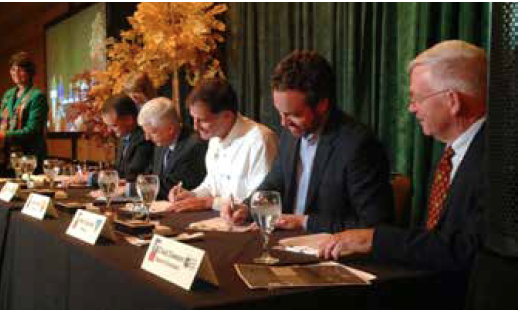Editorial Perspectives
August 2015 | Volume 21, Number 2
by ROBERT DVORAK
Protect. Connect. Foster.
These concepts summarize the 2020 Vision: Interagency Stewardship Priorities for America’s National Wilderness Preservation System. An agreement between the federal land management agencies (Figure 1), the 2020 Vision is intended to guide interagency collaboration and efforts toward the continued preservation of America’s wilderness resources. For the attendees of the October 2014 National Wilderness Conference in Albuquerque, New Mexico, it was an important moment for the wilderness community and an opportunity to envision what the future might hold for wilderness stewardship. This vision emphasizes three broad themes: (1) protect wilderness resources, (2) connect people to their wilderness heritage, and (3) foster excellence in wilderness leadership and coordination. As I examine it in its entirety, the priorities outlined are worthy of our dedicated efforts. We need to grow the infrastructure and capacity for wilderness stewardship. This includes institutional commitments to landscape assessment and preserving wilderness character. We need to prepare for ecological change and generate the science necessary to inform wilderness stewardship decisions. This means supporting the interagency Arthur Carhart National Wilderness Training Center, the Aldo Leopold Wilderness Research Institute, and partnerships with universities and academic institutions. We need to cultivate a wilderness workforce, based on a community of practice with consistent skills, training, and education. This means creating the next generation of wilderness stewards and providing them with the expertise and knowledge to manage our wilderness resources.

Figure 1 – The signing of the 2020 Vision document during the National Wilderness Conference in Albuquerque, New Mexico, on October 17, 2014. Connie Myers (left), director of the Arthur Carhart National Wilderness Training Center, and Chad Dawson, SUNY-ESF professor Emeritus (right) look on as the four directors sign their agency’s commitment to the 2020 Vision document: (left to right) Cam Sholly, National Park Service associate director; Thomas Tidwell, Forest Service chief; Dan Ashe, Fish and Wildlife Service director; and Neil Kornze, Bureau of Land Management director. Photo by Paul Dawson.
However, what resonates most with me is the 2020 Vision introduction, that “wilderness is every American’s story.” For wilderness to be relevant to this generation, and those in the future, how do we make it part of their story? How do we inspire future citizens to embrace wilderness and wild places as both their birthright and as a gift to nurture, protect, preserve, and pass on for future generations? Even more boldly, how can wilderness and wild places gain greater recognition as part of the “human story,” valued by all of us and recognized as vital to the human spirit? The idea of connecting people to wilderness or nurturing their connection is not necessarily unique. But it is timely, noble, and particularly critical to the success of the National Wilderness Preservation System. Every day that we delay to engage the next generation of wilderness stewards, advocates, and enthusiasts is an opportunity lost in continuing a wilderness legacy that fosters lifelong connections between people, places, and wild nature.
Protect. Connect. Foster.
In the 2020 Vision, these words represent more than just themes, or well-intended rhetoric to a supportive wilderness community. They demonstrate a recognition that successful wilderness stewardship requires these concepts to be pursued in unity, not independently. Our efforts cannot be divided across ecosystem protection, engaging the next generation, and professionalizing stewardship. Instead, efforts need to find synergy within these themes to progress wilderness stewardship in the next five years and beyond. In this issue of IJW, John Peden, Madalyn Russell, and Monica Harris describe service-learning partners for wilderness education. Derrick Taff, David Weinzimmer, and Peter Newman examine the experience of mountaineers in Denali National Park and Preserve. In addition, Stephen McCool presents the keys to building wilderness stewardship capacity for the next 50 years.
For access to the inter-agency 2020 Vision, visit http://www.wilderness.net/toolboxes/documents/50th/2020_Vision.pdf.
ROBERT DVORAK is managing editor of the International Journal of Wilderness and associate professor in the Department of Recreation, Parks, and Leisure Services Administration at Central Michigan University; email: dvora1rg@cmich.edu.
